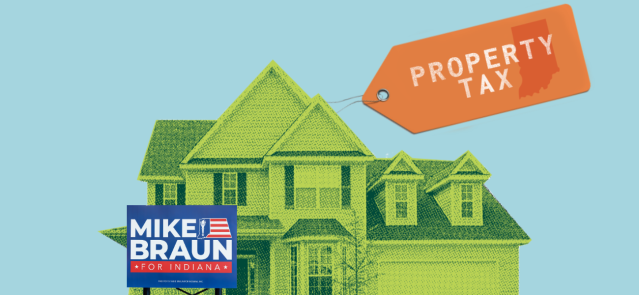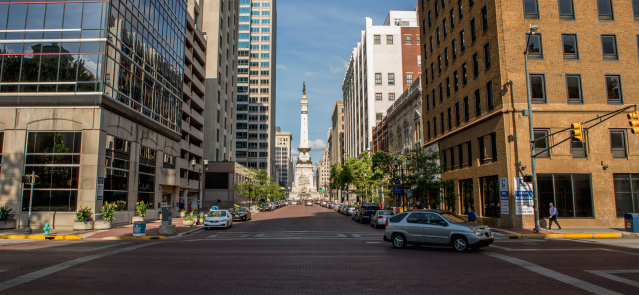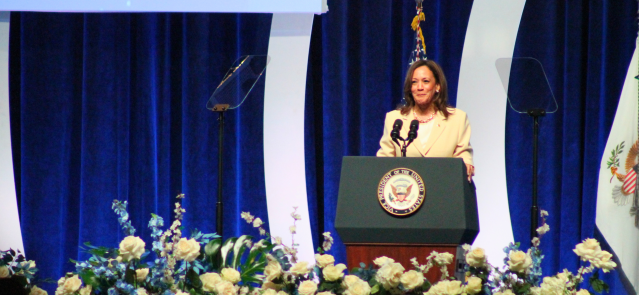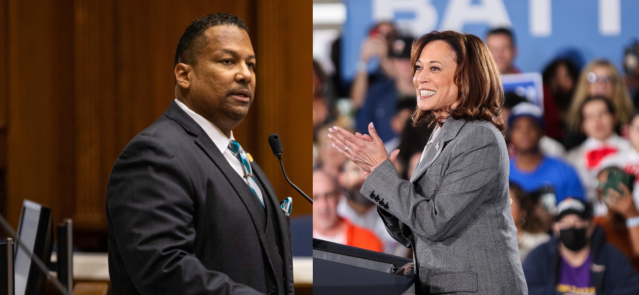Stay ahead of the curve as a political insider with deep policy analysis, daily briefings and policy-shaping tools.
Request a Demo‘It’s sort of a blowout’: Braun holds commanding lead in ‘State Affairs/Howey Politics Indiana’ poll
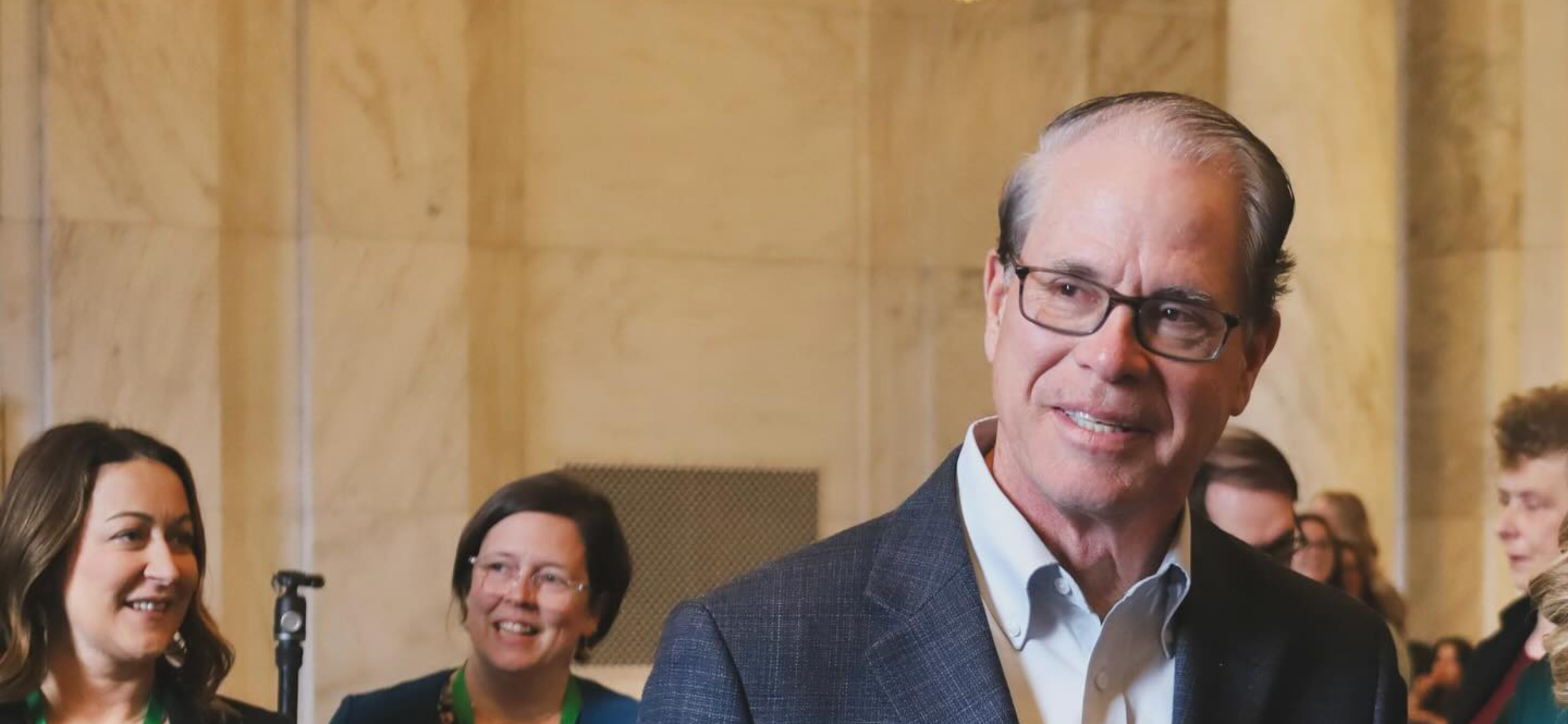
U.S. Sen. Mike Braun speaks at a Rare Disease Week event. (Credit: Office of Sen. Mike Braun)
U.S. Sen. Mike Braun holds a commanding lead in a new State Affairs/Howey Politics Indiana poll of likely Hoosier Republican voters in the May 7 gubernatorial primary.
Asked who they would vote for if the primary were held today, 44% of respondents picked Braun. Lt. Gov. Suzanne Crouch trailed with 10% of the vote, and Brad Chambers and Eric Doden each received 8%. Curtis Hill and Jamie Reitenour got 2% each, with 26% of poll respondents undecided.
This online survey comes after Chambers and Doden spent more than $19 million combined on TV advertising, according to AdImpact. While some of that spending went to basic biographical spots, much of it was aimed at Braun over issues such as police qualified immunity, the southern border and a podcast where Braun suggested he might attend a Black Lives Matters rally. During that same time, Braun spent $7.7 million, while Crouch spent $2.6 million.
“That is what we call a very commanding lead, where he’s 4-to-1 greater above each of the opponents,” pollster Ken Alper, president of SurveyUSA, said of Sen. Braun’s strength. “He’s well ahead among every demographic. It looks like it might be closest to moderates, but it’s more than 2-to-1 where he’s at 38% among moderates, while it’s 16% for Suzanne Crouch.
“It’s sort of a blowout,” Alper said of Braun’s lead in the poll, “so there’s not a lot of hope for the other candidates.”
Braun led with 47% among very conservative respondents, 44% among conservatives and 38% among moderates, with 23% undecided. He attracted 38% of support among women, compared to 10% for Crouch. Among voters who said the economy was the most important issue, Braun had 78% credibility. And he received 69% credibility among those who consider the southern border the most important issue.
>> Related: 2024 Indiana primary: What’s true in governor candidates’ ads
Alper said of the 26% undecided: “You do have roughly 1 in 4 voters who say they are undecided. We find a lot of the time people who tell us they are likely and then who say they are undecided are people who have actually rethought how likely they are to actually vote. A lot of them will end up not voting, but more often than not, those who do intend to vote break pretty much the same way as deciding voters.”
In addition, the poll shows that 49% of respondents are unfamiliar with Crouch. That’s despite the fact that she has served for more than seven years as lieutenant governor and almost a decade in the Statehouse, where she also did a stint as state auditor. Chambers (61% not familiar) and Doden (60%) paled to the just 16% who were not familiar with Sen. Braun, who also received “very favorable” or “somewhat favorable” opinions from a combined 59% of respondents. Crouch had a 30% favorable rating.
Despite veering to the right during this primary, Crouch had been raising money from some Democratic and independent women. State Affairs/Howey Politics Indiana asked Alper whether Crouch would have had a stronger survey showing if the poll had included more than Republicans or GOP-leaning independents.
“She probably would have done a little bit better, but without a really hard, boots-on-the ground effort to get Democrats to vote in the Republican primary, for the most part they just won’t,” Alper said. “Maybe 5%, maybe 7% to 10% if there’s a push and a backer. It’s not too surprising to say that even people who follow politics enough to vote aren’t paying attention enough to know who their lieutenant governor is. Specifically, that’s not someone they’re voting for individually.”
As for the issues most important to survey respondents this year, 77% said the economy was the most important, 68% said the southern border, 43% said crime and only 19% cited abortion as their key issue.
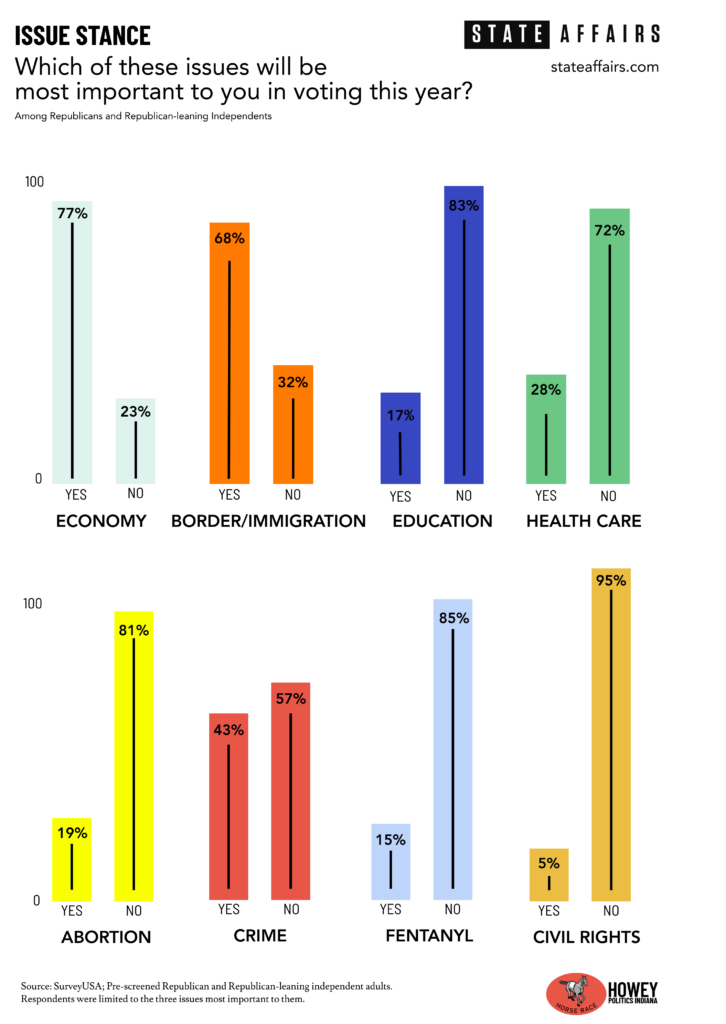
“You’re not too close to the border, which is interesting,” Alper said of Indiana’s location as a northern state. “It’s such an issue with the campaigns, I am not surprised that it sits at 68%, which is one of the top ones. It’s interesting how that has become nationalized all the way up to Indiana. Fentanyl hasn’t, and [those two issues] seem to go hand in hand.”
Alper added, “The economy usually dwarfs absolutely everything else 4 to 1. It is interesting to me that the border [as an issue] is so high in Indiana, that the border is so close to the economy, and crime isn’t.”
On whether the U.S. is on the right or wrong track, 87% of survey respondents said the latter, with only 8% saying the nation was doing well. And 43% think Indiana is headed in the right direction, while 39% said it’s on the wrong track.
Also, regarding the question, “Compared to four years ago, are you better off today? Worse off? Or are things about the same for you?” some 63% said they were worse off, 10% said better off and 27% said about the same.
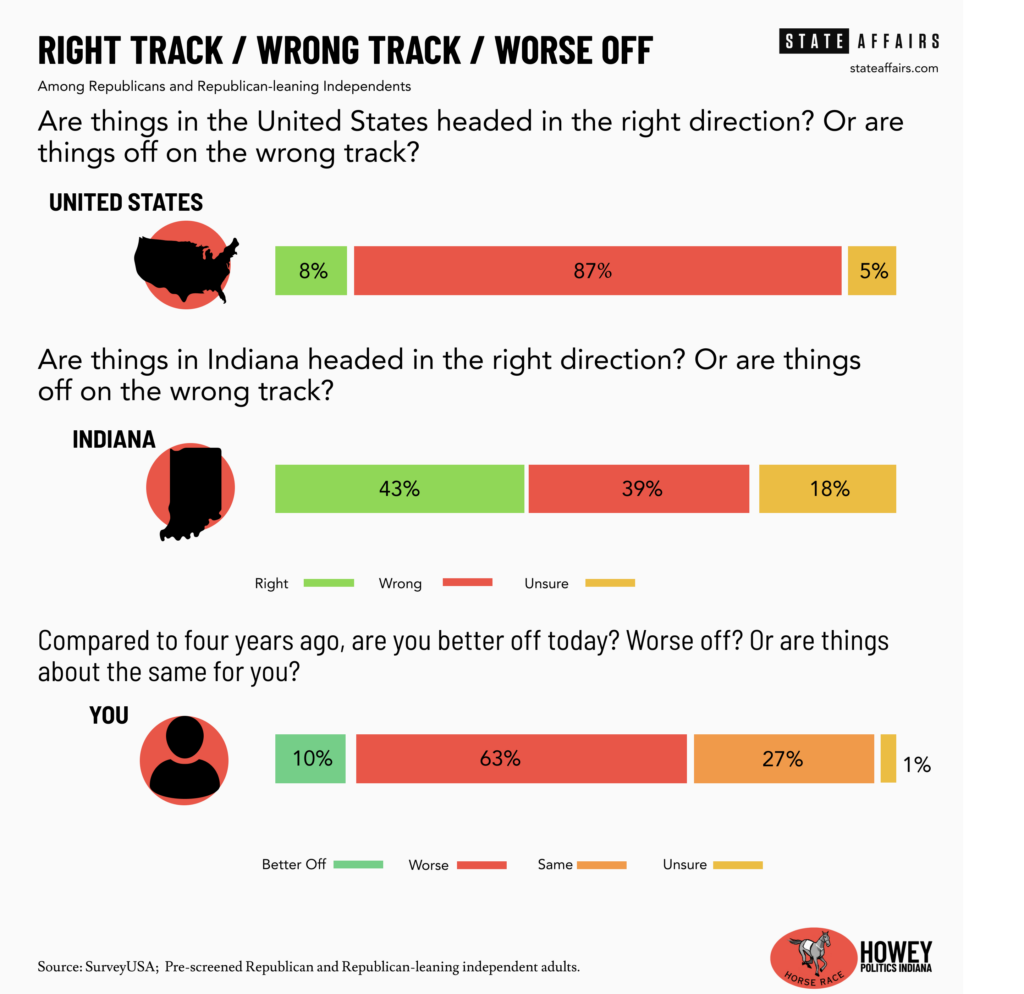
“That’s interesting and a good way to look at the difference between the two,” Alper said of the first two right/wrong-track numbers. “Wow, 8% saying the U.S. is in the right direction versus 43% for Indiana. That’s one of the largest differences on that [question] that we’ve ever seen. Roughly two-thirds are saying they are worse off, and of those who are saying they are better off … obviously they are a smaller number of people. Chambers voters are twice as likely to say they are better off than Braun voters at 26% versus 10%.”
Respondents gave presumed Republican presidential nominee Donald J. Trump a combined 83% approval, compared to 17% unfavorable, which is in line with recent primary states where Nikki Haley is still drawing some GOP votes despite having dropped out of the race in March. President Joe Biden is under water with Hoosier Republicans — 82% of respondents have a “very unfavorable” opinion of him despite the billions of dollars in federal infrastructure and pandemic relief funding rural broadband expansion, highway and bridge repairs, and the regional READI grants.
Crouch had hoped to be in second place at this point in the campaign, poised for a final breakout with $5 million to spend on a final media push. That strategy hinged on Chambers and Doden attacking Braun, thus softening him up. Crouch has not aimed any advertising at Braun to date. Alper said the 2% separating Crouch from Chambers and Doden was “negligible” after he was asked about which candidate was best poised to break out.
“The difference between 8% and 10% is really negligible,” Alper said. “It could be any of those three: Chambers, Crouch or Doden. Being a month out [from the primary] there would have to be a pretty significant stumble to cause a change in this,” he said, underscoring the widespread observation going into this election cycle that this was Sen. Braun’s race to lose.
An epic “stumble” occurred in the 2012 U.S. Senate race between Democratic Sen. Joe Donnelly and Republican Richard Mourdock, who tripped up during a statewide debate question on the abortion issue. The Donnelly-Mourdock race had been within the margin of error of every media, internal and advocacy group poll before the fateful Oct. 23 debate in New Albany. When the Howey Politics/DePauw Poll did its final survey, Donnelly jetted out to an 11% lead at 47%-36% on the way to a 5% upset plurality that November.
The final GOP gubernatorial debate will happen April 23 under the direction of the Indiana Debate Commission.
On Tuesday, the political action committee ReCenter Indiana announced it had placed three billboards in Evansville and Merrillville saying the Republican gubernatorial primary is open to Democrats and independent voters. Other billboards are planned for next week along Interstate 465 and North Keystone Avenue in Indianapolis. As part of a multilevel media campaign, ReCenter Indiana is running billboards across Indiana to supplement digital ads to urge Democrats to make a difference in the May 7 primary.
Don Knebel, a former longtime Barnes & Thornburg attorney and now president of ReCenter Indiana, said, “The May primary is the election that determines which Republican will be on the ballot in the fall. Judging from our state’s recent history, whoever that is will likely be our next governor.”
The State Affairs/Howey Politics Indiana poll, conducted by SurveyUSA, surveyed 700 Indiana adults on April 4-7 (447 respondents were likely to vote in the primary, with a margin of error of 4.47 percentage points). The sample was prescreened to exclude those who were not registered to vote and those who identified as Democrats, as Democratic-leaning independents or as independents. Thus, all 700 were identified as being registered to vote; of the registered voters, 17% were determined to be independents who lean Republican, 52% to be Republicans and 30% to be strong Republicans.

Read this related story:
Correction: This story has been updated to include the accurate percentage of poll respondents who said they were unfamiliar with Lt. Gov. Suzanne Crouch.
Brian A. Howey is senior writer and columnist for Howey Politics Indiana/State Affairs. Find Howey on Facebook and X @hwypol.
Know the most important news affecting Indiana
Get our free weekly newsletter that covers government, policy and politics that impact your everyday life—in 5 minutes or less.
4 things to know about Braun’s property tax proposal
Sen. Mike Braun, the Republican candidate for Indiana’s governor, released a plan for overhauling property taxes Friday morning that would impact millions of Hoosiers, Indiana schools and local governments. “Nothing is more important than ensuring Hoosiers can afford to live in their homes without being overburdened by rising property taxes driven by rapid inflation in …
Bureau of Motor Vehicles looks to add new rules to Indiana’s driving test
The Bureau of Motor Vehicles wants to amend Indiana’s driving skills test, putting “existing practice” into administrative rule. Indiana already fails drivers who speed, disobey traffic signals and don’t wear a seatbelt, among other violations. Yet the BMV is looking to make the state’s driving skills test more stringent. A proposed rule amendment looks to …
In Indianapolis, Harris says she’s fighting for America’s future
Vice President Kamala Harris, the presumptive Democratic presidential nominee, told a gathering of women of color in Indianapolis on Wednesday that she is fighting for America’s future. She contrasted her vision with another — one she said is “focused on the past.” “Across our nation, we are witnessing a full-on assault on hard-fought, hard-won freedoms …
Indiana Black Legislative Caucus endorses Harris, pledges future support
The Indiana Black Legislative Caucus unanimously voted Wednesday to endorse Vice President Kamala Harris’ presidential run and will look at ways to assist her candidacy, the caucus chair, state Rep. Earl Harris Jr., D-East Chicago, told State Affairs. The caucus is made up of 14 members of the Indiana General Assembly, all of whom are …

